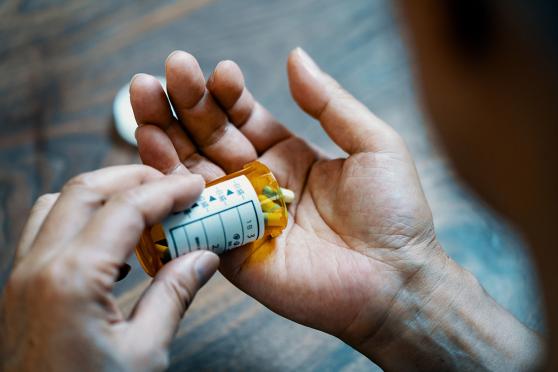10 ways to stop prediabetes in its tracks
Prediabetes is a warning that your blood sugar levels are high. The good news is there are steps you can take now to prevent diabetes in the future.

“You’ve got prediabetes.” If you’ve ever heard these words from your health care provider, your next thoughts were likely, “So what should I do now? Am I going to get diabetes?”
About 96 million U.S. adults age 18 or older have higher-than-normal blood sugar levels that raise the risk of developing type 2 diabetes. The good news? Plenty of research proves that simple strategies can delay or even prevent diabetes — and deliver other important health benefits too.
“If you have prediabetes, you have a lot of power in your lifestyle choices,” says Lauren Harris-Pincus, MS. She’s a registered dietitian nutritionist in private practice in New Jersey and the author of The Everything Easy Pre-Diabetes Cookbook.
“The truth is, you can get a significant improvement in your blood glucose (the medical term for blood sugar) with small changes like losing a little weight, eating more fruits and vegetables, and getting some physical activity that you like — I call it joyful movement — most days of the week.”
Easy steps such as these take aim at insulin resistance, the major cause of type 2 diabetes. It happens when your body loses sensitivity to insulin, the hormone that tells your cells to absorb blood sugar.
In the landmark Diabetes Prevention Program study, people who lost between 5 and 7 percent of their body weight ate more high-fiber food and less saturated fat. They also got 150 minutes of exercise weekly (that’s a half-hour walk five times a week) and slashed their risk for going from prediabetes to type 2 diabetes by 58 percent over three years. Older people (age 60-plus) in the study did even better, cutting their diabetes risk by 71 percent.
And the power of lifestyle lasts a long time. Maintaining healthy habits can cut your risk for diabetes by 27 to 39 percent over 15 to 30 years. That’s according to the American Diabetes Association’s 2021 recommendations for preventing type 2 diabetes.
That’s not all. The benefits ripple beyond your blood sugar numbers. Preventing diabetes also lowers your risk for serious health complications of type 2 diabetes, including nerve damage, vision problems, and reduced kidney function. The same lifestyle steps also help control high blood pressure and high cholesterol.
“You’ll feel good too when you eat a balanced diet that gives you the nutrients you need,” Harris-Pincus says. “My clients say they have more energy, less hunger, and even better moods.”
Here are 10 strategies to take aim at prediabetes.
1. Aim to trim a few pounds.
“You don’t have to lose large amounts of weight,” Harris-Pincus says. “Lose an amount that you can maintain.” Dropping 5 to 7 percent of your weight gives your blood sugar a hand by reducing deep abdominal fat. That type of fat sends fatty acids and inflammatory compounds into your bloodstream that dull insulin sensitivity.
2. Fill half your plate with produce.
Fiber and nutrients such as flavonoids in fruit and vegetables also help with insulin sensitivity. Fiber nurtures beneficial gut bacteria linked with insulin sensitivity, while flavonoids help with insulin signaling, research shows.
Start dinner with a side salad, replace half the pasta in your bowl with vegetables, or try Harris-Pincus’ favorite strategy: Roast a mix of onions, peppers, mushrooms, broccoli or any other veggie you love and store them in the fridge. “You can easily add them to omelets, sandwiches and salads,” she says. Keep plain frozen or canned vegetables on hand too for easy meal prep. Make fruit your go-to dessert. Keep unsweetened frozen fruit on hand for quick smoothies.
3. Swap in whole grains.
Fiber and nutrients in brown rice, whole-grain bread and pasta, oatmeal, and other whole grains help with insulin sensitivity and keep you feeling full, Harris-Pincus says. In contrast, she explains, “eating refined grains, ultra-processed foods and sweet drinks can make your blood sugar rise and then fall, so you feel hungry, irritable, and low on energy — and ready to reach for a doughnut instead of an apple or a salad.”
4. Choose lean proteins and good fats.
Saturated fat (found in fatty and processed meats) promotes insulin resistance. “Skinless chicken, fish, lean cuts of beef and pork, and tofu or beans are better options for your blood sugar,” Harris-Pincus says. So are the variety of good fats found in salmon, sardines, nuts, olive and canola oil, and avocados.
5. Say “no thanks” to sugary drinks and processed foods.
These can make your blood sugar soar and then drop. They may also promote inflammation that interferes with insulin sensitivity.
6. Take a daily walk.
Exercise has unique blood sugar benefits you won’t want to miss. Movement helps move glucose out of your bloodstream and into your muscle cells. It also increases your body’s sensitivity to insulin and plays a role in achieving and maintaining a healthier weight. Go for a brisk walk, ride your exercise bike, or work out in your living room with an exercise video or online class. You can even march in place while watching your favorite TV show. Physical activity is a cornerstone of your healthy blood sugar plan.
In fact, people in the Diabetes Prevention Program who got 150 minutes of weekly exercise but didn’t lose weight still cut their risk of developing diabetes by 44 percent. It’s also smart to take breaks from sitting throughout the day, recommends the American Diabetes Association.
7. Treat yourself to an early breakfast.
Taking your first bite before 8:30 a.m. could help your body obey insulin’s signals to absorb blood sugar. That’s according to a 2021 Northwestern University study that used eight years of national health survey information from 10,575 women and men.
8. Add a dash of cinnamon to your meals.
Having a small amount of cinnamon (500 milligrams, or about a fifth of a teaspoon of powdered cinnamon) three times a day lowered the blood sugar of people with prediabetes in a 2020 study from the Harvard Medical School–affiliated Joslin Diabetes Center. This popular spice has already been shown to lower fasting blood sugar levels by 10 to 15 percent in people with type 2 diabetes, possibly by helping blood sugar enter cells, the study authors say. You can sprinkle it over fruit, stir it into a bowl of oatmeal, or add a dash to a cup of coffee.
9. Make strength training part of your exercise routine.
Simple moves, such as using resistance bands or even your own body weight, help control weight and maintain and build muscle. Bonus: They may also enhance insulin sensitivity and improve blood sugar levels, say researchers from Harvard University and the National Institute on Aging.
One study that tracked 35,754 women for several years found that those who did any kind of strength training for about 20 minutes a week were 33 percent less likely to develop diabetes. In the Diabetes Prevention Program, participants did strength training for up to 75 minutes each week.
The current Physical Activity Guidelines for Americans call for adults to include at least two strength-training sessions a week. That’s in addition to 150-minutes of moderate-intensity aerobic activity every week, like brisk walking or fast dancing. Getting both kinds of activity provides bigger benefits. In the Harvard study, women who did both saw diabetes risk drop as much as 39 percent compared to non-exercisers. Studies in men have found similar benefits.
10. Seek support.
Sign up for an in-person or virtual program on lifestyle changes. Many YMCAs, hospitals, libraries, wellness centers, and senior centers offer classes based on the Diabetes Prevention Program. This gives you access to a trained educator and the support of others with prediabetes who are making the same journey.
Find a program recognized by the National Diabetes Prevention Program here. If you have Medicare, you may qualify for the Medicare Diabetes Prevention Program. Find out more here.


